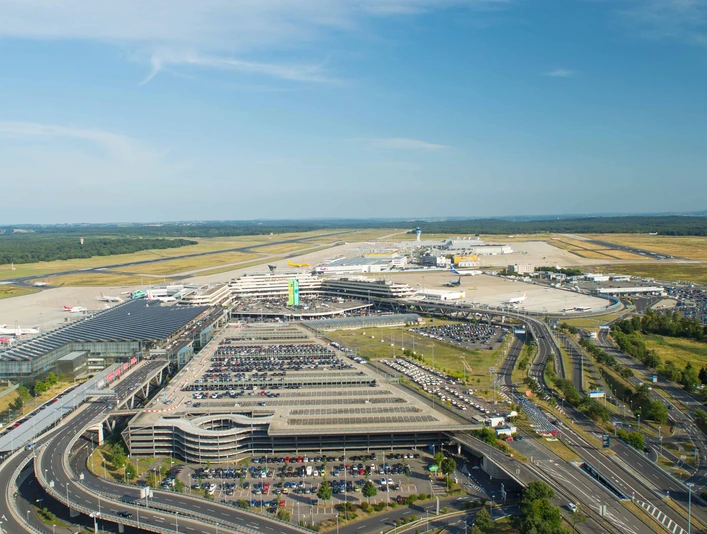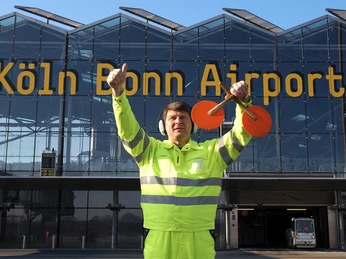"Welcome to Bonn. Cologne/Bonn," echoed years ago in a cool, seductive James Bond manner from the terminal speakers to greet arriving passengers in a humorous and thus typically Cologne style. Who wouldn’t want to land with James Bond, the person who came up with the idea might have thought, and in 2004, they secured none other than Frank Glaubrecht to voice the announcement. Frank Glaubrecht had already voiced John Sinclair audioplays and is very well known as the German voice of Al Pacino, Kevin Costner, and Pierce Brosnan. And Pierce Brosnan, in turn, played James Bond. Welcome to... Cologne/Bonn.
Even though the announcement no longer greets you today: The legend lives on and gives the airport 16 km from Cologne a special aura. Cologne/Bonn, as one of the major transport airports in Germany, is significant, ranking 7th in passenger numbers and 3rd in cargo flights. Additionally, CGN Airport shines with a rich history and illustrious passengers—due to its proximity to the former capital Bonn alone.
For example, in 1959, US President Eisenhower touched down on the airport runway. In 1961, the first long-haul flight was launched from here over Anchorage to Tokyo. Charles de Gaulle visited by plane in 1962, John F. Kennedy in 1963, and many more in the following years, like Pope John Paul II or US President Ronald Reagan. The airport continued to gain momentum: by 1978, it recorded over 2 million passengers annually.
The next sensation didn’t take long to follow: In 1984, the prestigious supersonic aircraft Concorde, “The Flying Pen,” with which you can fly faster than the earth rotates, landed in Cologne/Bonn to fly 100 passengers on a cruise to the Caribbean.
Finally, even the historic parabolic flight aircraft A300 ZERO-G found its final resting place in Cologne/Bonn. Aircraft like these were used for zero-gravity training for space travelers, initiated through a special and complex flight maneuver. Until 2014, the Airbus, which made its maiden flight in 1973, was in use for training, including for Alexander Gerst. By the way, you can view the A300 ZERO-G here at the airport.
A focus of the airport's corporate strategy—which is important for you as an environmentally conscious person—is climate protection and sustainability. By 2045, the airport aims to be completely climate-neutral. Years ago, solar panels were installed, among the largest at German airports and continuously expanded, alongside an in-house combined heat and power plant, innovative CO2-saving ventilation technology, an electric fleet with passenger stairs, aircraft tugs, and cars. Additionally, a hydrogen station, an innovative resource-conserving ice storage system which both cools and warms buildings, and the provision for airlines to refuel with sustainable aviation fuel enhance the airport's climate protection management.
Even though the announcement no longer greets you today: The legend lives on and gives the airport 16 km from Cologne a special aura. Cologne/Bonn, as one of the major transport airports in Germany, is significant, ranking 7th in passenger numbers and 3rd in cargo flights. Additionally, CGN Airport shines with a rich history and illustrious passengers—due to its proximity to the former capital Bonn alone.
An Airport and Its Highlights
The history of Cologne/Bonn Airport essentially began in 1949, after Bonn became the provisional government seat and needed to be connected to the international air traffic network: the official founding occurred on May 8, 1950. The following years were marked by the construction and expansion of the area, as well as a few highlights concerning aircraft and famous passengers, especially state guests.For example, in 1959, US President Eisenhower touched down on the airport runway. In 1961, the first long-haul flight was launched from here over Anchorage to Tokyo. Charles de Gaulle visited by plane in 1962, John F. Kennedy in 1963, and many more in the following years, like Pope John Paul II or US President Ronald Reagan. The airport continued to gain momentum: by 1978, it recorded over 2 million passengers annually.
Spectacular Landings and Aircraft
Technology enthusiasts will certainly get excited over the following list of aircraft and landings: In 1951, the De Havilland “Comet 1,” the world’s first jet airliner, landed in Cologne/Bonn. 1983 undoubtedly witnessed one of its most exciting days with a Star Trek-like experience: The Enterprise, NASA's Space Shuttle, landed on the back of a Boeing 747 in Cologne/Bonn, as one of the 60 worldwide NASA emergency landing sites.The next sensation didn’t take long to follow: In 1984, the prestigious supersonic aircraft Concorde, “The Flying Pen,” with which you can fly faster than the earth rotates, landed in Cologne/Bonn to fly 100 passengers on a cruise to the Caribbean.
Finally, even the historic parabolic flight aircraft A300 ZERO-G found its final resting place in Cologne/Bonn. Aircraft like these were used for zero-gravity training for space travelers, initiated through a special and complex flight maneuver. Until 2014, the Airbus, which made its maiden flight in 1973, was in use for training, including for Alexander Gerst. By the way, you can view the A300 ZERO-G here at the airport.
Visitors’ Terrace or Tour: Experience CGN
At Cologne/Bonn Airport, you cannot only land to visit the Cathedral City—with just a 15-minute train ride to the main station—but as an airplane fan and technology enthusiast, you can also tour it. For instance, free of charge from the visitors’ terrace: You can watch planes on the runway, see the aprons, cargo areas, and maybe even feel the turbine winds. Or you could take part in a visitor tour, for which, given its popularity, it is best to register well in advance. What will you experience? A behind-the-scenes look, aircraft handling, and many other work steps, information about noise protection measures, as well as the eventful history of the airport.Climate Protection and Sustainability
A focus of the airport's corporate strategy—which is important for you as an environmentally conscious person—is climate protection and sustainability. By 2045, the airport aims to be completely climate-neutral. Years ago, solar panels were installed, among the largest at German airports and continuously expanded, alongside an in-house combined heat and power plant, innovative CO2-saving ventilation technology, an electric fleet with passenger stairs, aircraft tugs, and cars. Additionally, a hydrogen station, an innovative resource-conserving ice storage system which both cools and warms buildings, and the provision for airlines to refuel with sustainable aviation fuel enhance the airport's climate protection management.
CGN in Numbers
Approximately 9.75 million people use the airport annually. About 30 airlines fly from here to around 110 destinations worldwide. Hundreds of thousands of parcels and letters are transshipped daily, and approximately 15,000 people are employed here, by companies and authorities on-site. In total, the airport grounds cover 1000 hectares—and CGN features a 3-runway system: an intercontinental runway of 3,815 meters, a parallel runway of 1,863 meters, and a crosswind runway of 2,459 meters.FunFact: CGN Has Its Own Soundtrack
In 1977, British musician Brian Eno spent a few hours at Cologne/Bonn Airport. He found the modern building exceptional but the sound atmosphere so dreadful that he immediately began developing compositions from overlapping tape loops, called Music for Airports. These loops were intended to have a calming effect on passengers and visitors and provide them with space to think. Have a good flight from Bonn. Cologne/Bonn. Or back home.Useful Information
Eligibility
Bad Weather Offer
Suitable for any weather
for Groups
for Class
for families
for individual guests
Suitable for the Elderly
Price info
Cologne Bonn Airport offers a wide range of additional services, including parking facilities. For stress-free travel planning, we recommend that you find out about prices and availability in advance.
Payment methods
Entrance Free
Parking facilities
The airport is easy to reach by bus or train.
The airport is right next to the motorway A59. Just take the “Flughafen“ exit, and you are directly at the terminals or one of the car parks.
The airport is right next to the motorway A59. Just take the “Flughafen“ exit, and you are directly at the terminals or one of the car parks.
General information
Parking Available
Bus stop available
Nearby


